
Filter News
Area of Research
- Advanced Manufacturing (1)
- Biology and Environment (71)
- Computational Biology (1)
- Computational Engineering (3)
- Computer Science (6)
- Electricity and Smart Grid (1)
- Energy Science (81)
- Fusion and Fission (2)
- Fusion Energy (1)
- Isotopes (6)
- Materials (34)
- Materials for Computing (7)
- Mathematics (1)
- National Security (13)
- Neutron Science (13)
- Nuclear Science and Technology (2)
- Quantum information Science (1)
- Sensors and Controls (1)
- Supercomputing (51)
News Type
News Topics
- (-) Biomedical (41)
- (-) Environment (126)
- (-) Grid (45)
- (-) High-Performance Computing (55)
- (-) Machine Learning (37)
- (-) Mercury (9)
- (-) Polymers (28)
- (-) Summit (32)
- 3-D Printing/Advanced Manufacturing (95)
- Advanced Reactors (27)
- Artificial Intelligence (60)
- Big Data (37)
- Bioenergy (65)
- Biology (74)
- Biotechnology (21)
- Buildings (46)
- Chemical Sciences (57)
- Clean Water (23)
- Composites (26)
- Computer Science (119)
- Coronavirus (34)
- Critical Materials (25)
- Cybersecurity (26)
- Education (3)
- Element Discovery (1)
- Emergency (1)
- Energy Storage (88)
- Exascale Computing (17)
- Fossil Energy (2)
- Frontier (20)
- Fusion (35)
- Hydropower (8)
- Irradiation (2)
- Isotopes (38)
- ITER (6)
- Materials (105)
- Materials Science (105)
- Mathematics (8)
- Microelectronics (1)
- Microscopy (39)
- Molten Salt (8)
- Nanotechnology (47)
- National Security (38)
- Neutron Science (91)
- Nuclear Energy (63)
- Partnerships (35)
- Physics (46)
- Quantum Computing (19)
- Quantum Science (48)
- Security (20)
- Simulation (27)
- Space Exploration (13)
- Statistics (2)
- Transportation (74)
Media Contacts

Researchers at Oak Ridge National Laboratory have opened a new virtual library where visitors can check out waveforms instead of books. So far, more than 350 users worldwide have utilized the library, which provides vital understanding of an increasingly complex grid.

Oak Ridge National Laboratory scientists have developed a method leveraging artificial intelligence to accelerate the identification of environmentally friendly solvents for industrial carbon capture, biomass processing, rechargeable batteries and other applications.

Oak Ridge National Laboratory scientists ingeniously created a sustainable, soft material by combining rubber with woody reinforcements and incorporating “smart” linkages between the components that unlock on demand.

John Lagergren, a staff scientist in Oak Ridge National Laboratory’s Plant Systems Biology group, is using his expertise in applied math and machine learning to develop neural networks to quickly analyze the vast amounts of data on plant traits amassed at ORNL’s Advanced Plant Phenotyping Laboratory.

Researchers at ORNL are developing battery technologies to fight climate change in two ways, by expanding the use of renewable energy and capturing airborne carbon dioxide.

Scientists at ORNL completed a study of how well vegetation survived extreme heat events in both urban and rural communities across the country in recent years. The analysis informs pathways for climate mitigation, including ways to reduce the effect of urban heat islands.

Groundwater withdrawals are expected to peak in about one-third of the world’s basins by 2050, potentially triggering significant trade and agriculture shifts, a new analysis finds.

Alyssa Carrell started her science career studying the tallest inhabitants in the forest, but today is focused on some of its smallest — the microbial organisms that play an outsized role in plant health.
The United States could triple its current bioeconomy by producing more than 1 billion tons per year of plant-based biomass for renewable fuels, while meeting projected demands for food, feed, fiber, conventional forest products and exports, according to the DOE’s latest Billion-Ton Report led by ORNL.

Kate Evans, director for the Computational Sciences and Engineering Division at ORNL, has been awarded the 2024 Society for Industrial and Applied Mathematicians Activity Group on Mathematics of Planet Earth Prize.


